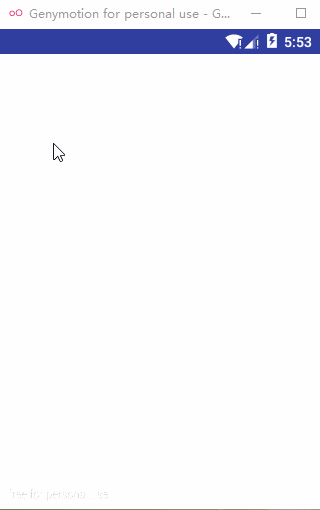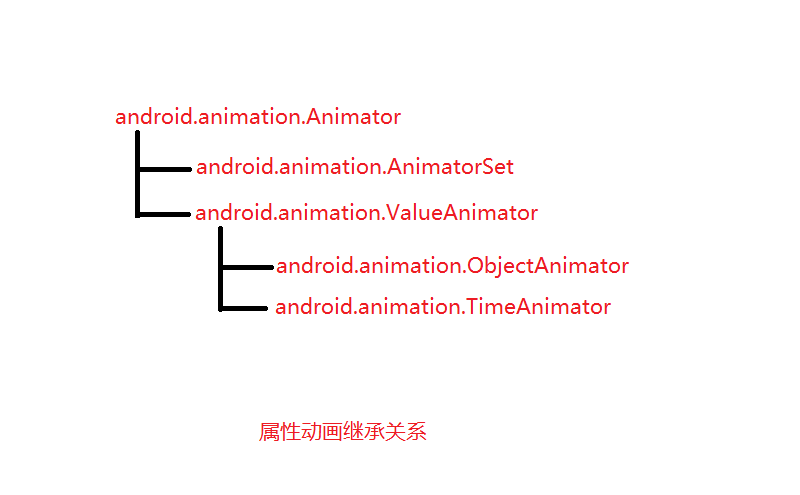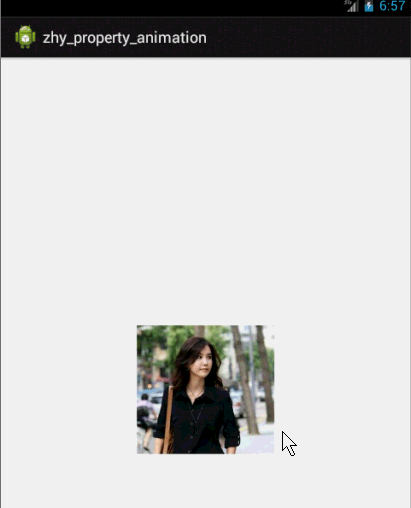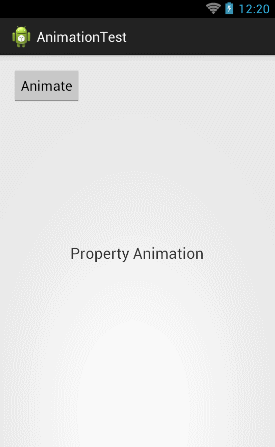下面就开始学习属性动画的基本用法,我们来看属性动画的继承关系,如下如所示:
显然关注的焦点应该是ValueAnimator,ObjectAnimator这两个类啦,ObjectAnimator继承自ValueAnimator,是属性动画中非常重要的一个实现类,通过ObjectAnimator类的静态欧工厂方法来创建ObjectAnimator对象,这些静态工厂方法包括:ObjectAnimator.ofFloat(),ObjectAnimator.ofInt()等等,当然最为重要的一个静态工厂方法是ObjectAnimator.ofObject(),可以接收一个Object对象并为其设置属性动画,瞬间高大上了有木有?这些静态工厂方法接收的参数分别是:
要设置动画的目标对象;
动画的属性类型;
一个或多个属性值;当只指定一个属性值,系统默认此值为结束值;当指定两个属性值,系统默认分别为起始值和结束值;当指定三个或三个以上时,系统默认线性插值;
ValueAnimator是整个属性动画机制当中最核心的一个类,前面我们已经提到了,属性动画的运行机制是通过不断地对值进行操作来实现的,而初始值和结束值之间的动画过渡就是由ValueAnimator这个类来负责计算的,ValueAnimator对过渡动画值的计算依靠一个时间因子fraction,而这个时间因子fraction是系统由setDuration()方法设置的动画执行时间通过计算得来的,所以ValueAnimator还负责管理动画的持续时间、播放次数、播放模式、以及对动画设置监听器等,确实是一个非常重要的类。
相关API
Property Animation故名思议就是通过动画的方式改变对象的属性了,我们首先需要了解几个属性:
Duration动画的持续时间,默认300ms。
Time interpolation:时间差值,乍一看不知道是什么,但是我说LinearInterpolator、AccelerateDecelerateInterpolator,大家一定知道是干嘛的了,定义动画的变化率。
Repeat count and behavior:重复次数、以及重复模式;可以定义重复多少次;重复时从头开始,还是反向。
Animator sets: 动画集合,你可以定义一组动画,一起执行或者顺序执行。
Frame refresh delay:帧刷新延迟,对于你的动画,多久刷新一次帧;默认为10ms,但最终依赖系统的当前状态;基本不用管。
相关的类
ObjectAnimator 动画的执行类,后面详细介绍
ValueAnimator 动画的执行类,后面详细介绍
AnimatorSet 用于控制一组动画的执行:线性,一起,每个动画的先后执行等。
AnimatorInflater 用户加载属性动画的xml文件
TypeEvaluator 类型估值,主要用于设置动画操作属性的值。
TimeInterpolator 时间插值,上面已经介绍。
总的来说,属性动画就是,动画的执行类来设置动画操作的对象的属性、持续时间,开始和结束的属性值,时间差值等,然后系统会根据设置的参数动态的变化对象的属性。
ValueAnimator
ValueAnimator是整个属性动画机制当中最核心的一个类,属性动画的运行机制是通过不断地对值进行操作来实现的,而初始值和结束值之间的动画过渡就是由ValueAnimator这个类来负责计算的。它的内部使用一种时间循环的机制来计算值与值之间的动画过渡,我们只需要将初始值和结束值提供给ValueAnimator,并且告诉它动画所需运行的时长,那么ValueAnimator就会自动帮我们完成从初始值平滑地过渡到结束值这样的效果。除此之外,ValueAnimator还负责管理动画的播放次数、播放模式、以及对动画设置监听器等,确实是一个非常重要的类。
但是ValueAnimator的用法却一点都不复杂,我们先从最简单的功能看起吧,比如说想要将一个值从0平滑过渡到1,时长300毫秒,就可以这样写:
ValueAnimator anim = ValueAnimator.ofFloat(0f, 1f);
anim.setDuration(300);
anim.start();很简单吧,调用ValueAnimator的ofFloat()方法就可以构建出一个ValueAnimator的实例,ofFloat()方法当中允许传入多个float类型的参数,这里传入0和1就表示将值从0平滑过渡到1,然后调用ValueAnimator的setDuration()方法来设置动画运行的时长,最后调用start()方法启动动画。
用法就是这么简单,现在如果你运行一下上面的代码,动画就会执行了。可是这只是一个将值从0过渡到1的动画,又看不到任何界面效果,我们怎样才能知道这个动画是不是已经真正运行了呢?这就需要借助监听器来实现了,如下所示:
ValueAnimator anim = ValueAnimator.ofFloat(0f, 1f);
anim.setDuration(300);
anim.addUpdateListener(new ValueAnimator.AnimatorUpdateListener() {
@Override
public void onAnimationUpdate(ValueAnimator animation) {
float currentValue = (float) animation.getAnimatedValue();
Log.d("TAG", "cuurent value is " + currentValue);
}
});
anim.start()ObjectAnimator
相比于ValueAnimator,ObjectAnimator可能才是我们最常接触到的类,因为ValueAnimator只不过是对值进行了一个平滑的动画过渡,但我们实际使用到这种功能的场景好像并不多。而ObjectAnimator则就不同了,它是可以直接对任意对象的任意属性进行动画操作的;
下面举几个例子(csdn上面的例子)
一个动画能够让View既可以缩小、又能够淡出(3个属性scaleX,scaleY,alpha),只使用ObjectAnimator咋弄?
public void rotateyAnimRun(final View view)
{
ObjectAnimator anim = ObjectAnimator//
.ofFloat(view, "zhy", 1.0F, 0.0F)//
.setDuration(500);//
anim.start();
anim.addUpdateListener(new AnimatorUpdateListener()
{
@Override
public void onAnimationUpdate(ValueAnimator animation)
{
float cVal = (Float) animation.getAnimatedValue();
view.setAlpha(cVal);
view.setScaleX(cVal);
view.setScaleY(cVal);
}
});
} 其实还有更简单的方式,实现一个动画更改多个效果:使用propertyValuesHolder
public void propertyValuesHolder(View view)
{
PropertyValuesHolder pvhX = PropertyValuesHolder.ofFloat("alpha", 1f,
0f, 1f);
PropertyValuesHolder pvhY = PropertyValuesHolder.ofFloat("scaleX", 1f,
0, 1f);
PropertyValuesHolder pvhZ = PropertyValuesHolder.ofFloat("scaleY", 1f,
0, 1f);
ObjectAnimator.ofPropertyValuesHolder(view, pvhX, pvhY,pvhZ).setDuration(1000).start();
}
//AnimatorSet
ObjectAnimator moveIn = ObjectAnimator.ofFloat(textview, "translationX", -500f, 0f);
ObjectAnimator rotate = ObjectAnimator.ofFloat(textview, "rotation", 0f, 360f);
ObjectAnimator fadeInOut = ObjectAnimator.ofFloat(textview, "alpha", 1f, 0f, 1f);
AnimatorSet animSet = new AnimatorSet();
animSet.play(rotate).with(fadeInOut).after(moveIn);
animSet.setDuration(5000);
animSet.start(); 到目前为止,ObjectAnimator的用法还算是相当简单吧,但是我相信肯定会有不少朋友现在心里都有同样一个疑问,就是ofFloat()方法的第二个参数到底可以传哪些值呢?目前我们使用过了alpha、rotation、translationX和scaleY这几个值,分别可以完成淡入淡出、旋转、水平移动、垂直缩放这几种动画,那么还有哪些值是可以使用的呢?其实这个问题的答案非常玄乎,就是我们可以传入任意的值到ofFloat()方法的第二个参数当中。任意的值?相信这很出乎大家的意料吧,但事实就是如此。因为ObjectAnimator在设计的时候就没有针对于View来进行设计,而是针对于任意对象的,它所负责的工作就是不断地向某个对象中的某个属性进行赋值,然后对象根据属性值的改变再来决定如何展现出来。
那么比如说我们调用下面这样一段代码:
ObjectAnimator.ofFloat(textview, "alpha", 1f, 0f); 其实这段代码的意思就是ObjectAnimator会帮我们不断地改变textview对象中alpha属性的值,从1f变化到0f。然后textview对象需要根据alpha属性值的改变来不断刷新界面的显示,从而让用户可以看出淡入淡出的动画效果。
那么textview对象中是不是有alpha属性这个值呢?没有,不仅textview没有这个属性,连它所有的父类也是没有这个属性的!这就奇怪了,textview当中并没有alpha这个属性,ObjectAnimator是如何进行操作的呢?其实ObjectAnimator内部的工作机制并不是直接对我们传入的属性名进行操作的,而是会去寻找这个属性名对应的get和set方法,因此alpha属性所对应的get和set方法应该就是:
public void setAlpha(float value);
public float getAlpha(); 那么textview对象中是否有这两个方法呢?确实有,并且这两个方法是由View对象提供的,也就是说不仅TextView可以使用这个属性来进行淡入淡出动画操作,任何继承自View的对象都可以的。
既然alpha是这个样子,相信大家一定已经明白了,前面我们所用的所有属性都是这个工作原理,那么View当中一定也存在着setRotation()、getRotation()、setTranslationX()、getTranslationX()、setScaleY()、getScaleY()这些方法,不信的话你可以到View当中去找一下。
桌面弹球和Win10开机小圆点旋转动画的实例探究
布局文件先定义了4个小圆点ImageView,把每个小圆点ImageView都放在了一个LinearLayout中,这很简单!说到绘制小圆点,我比较推荐的一种做法是在res/drawable目录下直接通过xml定义shape资源文件,这样定义的好处是可以避免使用图片资源造成不必要的内存占用。这里我把我的小圆点定义代码贴一下:
<?xml version="1.0" encoding="utf-8"?>
<shape
xmlns:android="http://schemas.android.com/apk/res/android"
android:shape="oval">
<solid android:color="@android:color/holo_red_dark" />
</shape>际上我们定义的只是一个椭圆,要显示出小圆点我们需要指定它的宽高相等,即android:layout_width和android:layout_height的值要相等,否则就会显示椭圆。然后只需要像引用图片资源一样,在drawable目录下引用它就好,比如:
<LinearLayout
android:id="@+id/ll_point_circle_4"
android:layout_width="wrap_content"
android:layout_height="240dp"
android:layout_centerInParent="true"
android:orientation="vertical">
<ImageView
android:layout_width="40dp"
android:layout_height="40dp"
android:src="@drawable/shape_point" />
</LinearLayout>下面是完整的布局文件,仅供参考:
<RelativeLayout xmlns:android="http://schemas.android.com/apk/res/android"
android:layout_width="match_parent"
android:layout_height="match_parent">
<Button
android:id="@+id/start_ani_2"
android:layout_width="wrap_content"
android:layout_height="wrap_content"
android:layout_centerHorizontal="true"
android:text="@string/start_ani" />
<RelativeLayout
android:layout_width="match_parent"
android:layout_height="match_parent"
android:layout_centerVertical="true">
<LinearLayout
android:id="@+id/ll_point_circle_1"
android:layout_width="wrap_content"
android:layout_height="240dp"
android:layout_centerInParent="true"
android:orientation="vertical">
<ImageView
android:layout_width="40dp"
android:layout_height="40dp"
android:src="@drawable/shape_point"
/>
</LinearLayout>
<LinearLayout
android:id="@+id/ll_point_circle_2"
android:layout_width="wrap_content"
android:layout_height="240dp"
android:layout_centerInParent="true"
android:orientation="vertical">
<ImageView
android:layout_width="40dp"
android:layout_height="40dp"
android:src="@drawable/shape_point"
/>
</LinearLayout>
<LinearLayout
android:id="@+id/ll_point_circle_3"
android:layout_width="wrap_content"
android:layout_height="240dp"
android:layout_centerInParent="true"
android:orientation="vertical">
<ImageView
android:layout_width="40dp"
android:layout_height="40dp"
android:src="@drawable/shape_point"
/>
</LinearLayout>
<LinearLayout
android:id="@+id/ll_point_circle_4"
android:layout_width="wrap_content"
android:layout_height="240dp"
android:layout_centerInParent="true"
android:orientation="vertical">
<ImageView
android:layout_width="40dp"
android:layout_height="40dp"
android:src="@drawable/shape_point"
/>
</LinearLayout>
</RelativeLayout>
</RelativeLayout>接着把CircleProgress属性动画类的代码贴出来,并在CircleProgress属性动画类中拿到上面4个小圆点的对象
package com.wondertwo.propertyanime;
import android.animation.AnimatorSet;
import android.animation.ObjectAnimator;
import android.app.Activity;
import android.os.Bundle;
import android.view.View;
import android.view.animation.AccelerateDecelerateInterpolator;
import android.widget.Button;
import android.widget.LinearLayout;
/**
* ObjectAnimator高级实例探究
* Created by wondertwo on 2016/3/22.
*/
public class CircleProgress extends Activity {
private LinearLayout mPoint_1;
private LinearLayout mPoint_2;
private LinearLayout mPoint_3;
private LinearLayout mPoint_4;
@Override
protected void onCreate(Bundle savedInstanceState) {
super.onCreate(savedInstanceState);
setContentView(R.layout.activity_circle_progress);
mPoint_1 = (LinearLayout) findViewById(R.id.ll_point_circle_1);
mPoint_2 = (LinearLayout) findViewById(R.id.ll_point_circle_2);
mPoint_3 = (LinearLayout) findViewById(R.id.ll_point_circle_3);
mPoint_4 = (LinearLayout) findViewById(R.id.ll_point_circle_4);
Button startAni = (Button) findViewById(R.id.start_ani_2);
startAni.setOnClickListener(new View.OnClickListener() {
@Override
public void onClick(View v) {
beginPropertyAni();
}
});
}
/**
* 开启动画
*/
private void beginPropertyAni() {
ObjectAnimator animator_1 = ObjectAnimator.ofFloat(
mPoint_1,
"rotation",
0,
360);
animator_1.setDuration(2000);
animator_1.setInterpolator(new AccelerateDecelerateInterpolator());
ObjectAnimator animator_2 = ObjectAnimator.ofFloat(
mPoint_2,
"rotation",
0,
360);
animator_2.setStartDelay(150);
animator_2.setDuration(2000 + 150);
animator_2.setInterpolator(new AccelerateDecelerateInterpolator());
ObjectAnimator animator_3 = ObjectAnimator.ofFloat(
mPoint_3,
"rotation",
0,
360);
animator_3.setStartDelay(2 * 150);
animator_3.setDuration(2000 + 2 * 150);
animator_3.setInterpolator(new AccelerateDecelerateInterpolator());
ObjectAnimator animator_4 = ObjectAnimator.ofFloat(
mPoint_4,
"rotation",
0,
360);
animator_4.setStartDelay(3 * 150);
animator_4.setDuration(2000 + 3 * 150);
animator_4.setInterpolator(new AccelerateDecelerateInterpolator());
AnimatorSet animatorSet = new AnimatorSet();
animatorSet.play(animator_1).with(animator_2).with(animator_3).with(animator_4);
animatorSet.start();
}
}代码确实不长只有80多行,但是麻雀虽小五脏俱全,很显然beginPropertyAni()方法就是启动动画的方法,调用ObjectAnimator.ofFloat()静态工厂方法创建ObjectAnimator对象我就不解释了,很容易看懂!重点来了,Win10开机小圆点旋转动画的难点不在旋转,如果我们把旋转的最高点看作是旋转的起始点,小圆点的旋转是一个先加速后减速的过程,这恰好符合高中物理的规律,小球内切圆环轨道做圆周运动,不知道我这样解释是不是很形象呢?那么控制旋转的加速度很好办,只要设置一个AccelerateDecelerateInterpolator()插值器就OK,但是我们发现,这不是一个小球在旋转,而是有4个同时在旋转,而且旋转还不同步,这又该如何解决呢?你只要从第二个小球开始,每个小球设置固定时间间隔的延时启动,就能完美解决上面的问题。代码是这样的:
animator_2.setStartDelay(150);
animator_3.setStartDelay(2 * 150);
animator_4.setStartDelay(3 * 150);

在动画中可以清晰的看到小球下落过程中的加速运动,碰到桌面(手机屏幕的底部)后的变形压扁,以及小球弹起的动画,非常形象生动!先贴代码后面再做分析:
package com.wondertwo.propertyanime;
import android.animation.Animator;
import android.animation.AnimatorListenerAdapter;
import android.animation.AnimatorSet;
import android.animation.ObjectAnimator;
import android.animation.ValueAnimator;
import android.app.Activity;
import android.content.Context;
import android.graphics.Canvas;
import android.graphics.Color;
import android.graphics.Paint;
import android.graphics.RadialGradient;
import android.graphics.Shader;
import android.graphics.drawable.ShapeDrawable;
import android.graphics.drawable.shapes.OvalShape;
import android.os.Bundle;
import android.view.MotionEvent;
import android.view.View;
import android.view.animation.AccelerateInterpolator;
import android.view.animation.DecelerateInterpolator;
import android.widget.LinearLayout;
import java.util.ArrayList;
/**
* 小球下落动画加强版XBallsFallActivity,增加了小球桌底时的压扁、回弹动画
* Created by wondertwo on 2016/3/20.
*/
public class XBallsFallActivity extends Activity {
static final float BALL_SIZE = 50f;// 小球直径
static final float FULL_TIME = 1000;// 下落时间
@Override
public void onCreate(Bundle savedInstanceState) {
super.onCreate(savedInstanceState);
setContentView(R.layout.activity_x_ball_fall);
LinearLayout xContainer = (LinearLayout) findViewById(R.id.xcontainer);
// 设置要显示的view组件
xContainer.addView(new XBallView(this));
}
/**
* 自定义动画组件XBallView
*/
public class XBallView extends View implements ValueAnimator.AnimatorUpdateListener {
public final ArrayList<XShapeHolder> balls = new ArrayList<>();// 创建balls集合来存储XShapeHolder对象
public XBallView(Context context) {
super(context);
setBackgroundColor(Color.WHITE);
}
@Override
public boolean onTouchEvent(MotionEvent event) {
// 屏蔽ACTION_UP事件
if (event.getAction() != MotionEvent.ACTION_DOWN && event.getAction() != MotionEvent.ACTION_MOVE) {
return false;
}
// 在ACTION_DOWN事件发生点生成小球
XShapeHolder newBall = addBall(event.getX(), event.getY());
// 计算小球下落动画开始时Y坐标
float startY = newBall.getY();
// 计算小球下落动画结束时的Y坐标,即屏幕高度减去startY
float endY = getHeight() - BALL_SIZE;
// 获取屏幕高度
float h = (float) getHeight();
float eventY = event.getY();
// 计算动画持续时间
int duration = (int) (FULL_TIME * ((h - eventY) / h));
/**
* 下面开始定义小球的下落,着地压扁,反弹等属性动画
*/
// 定义小球下落动画
ValueAnimator fallAni = ObjectAnimator.ofFloat(
newBall,
"y",
startY,
endY);
// 设置动画持续时间
fallAni.setDuration(duration);
// 设置加速插值器
fallAni.setInterpolator(new AccelerateInterpolator());
// 添加addUpdateListener监听器,当ValueAnimator属性值改变时会激发事件监听方法
fallAni.addUpdateListener(this);
// 定义小球压扁动画,控制小球x坐标左移半个球宽度
ValueAnimator squashshAni1 = ObjectAnimator.ofFloat(
newBall,
"x",
newBall.getX(),
newBall.getX() - BALL_SIZE / 2);
squashshAni1.setDuration(duration / 4);
squashshAni1.setRepeatCount(1);
squashshAni1.setRepeatMode(ValueAnimator.REVERSE);
squashshAni1.setInterpolator(new DecelerateInterpolator());
// 添加addUpdateListener监听器,当ValueAnimator属性值改变时会激发事件监听方法
squashshAni1.addUpdateListener(this);
// 定义小球压扁动画,控制小球宽度加倍
ValueAnimator squashshAni2 = ObjectAnimator.ofFloat(
newBall,
"width",
newBall.getWidth(),
newBall.getWidth() + BALL_SIZE);
squashshAni2.setDuration(duration / 4);
squashshAni2.setRepeatCount(1);
squashshAni2.setRepeatMode(ValueAnimator.REVERSE);
squashshAni2.setInterpolator(new DecelerateInterpolator());
// 添加addUpdateListener监听器,当ValueAnimator属性值改变时会激发事件监听方法
squashshAni2.addUpdateListener(this);
// 定义小球拉伸动画, 控制小球的y坐标下移半个球高度
ValueAnimator stretchAni1 = ObjectAnimator.ofFloat(
newBall,
"y",
endY,
endY + BALL_SIZE / 2);
stretchAni1.setDuration(duration / 4);
stretchAni1.setRepeatCount(1);
stretchAni1.setRepeatMode(ValueAnimator.REVERSE);
stretchAni1.setInterpolator(new DecelerateInterpolator());
// 添加addUpdateListener监听器,当ValueAnimator属性值改变时会激发事件监听方法
stretchAni1.addUpdateListener(this);
// 定义小球拉伸动画, 控制小球的高度减半
ValueAnimator stretchAni2 = ObjectAnimator.ofFloat(
newBall,
"height",
newBall.getHeight(),
newBall.getHeight() - BALL_SIZE / 2);
stretchAni2.setDuration(duration / 4);
stretchAni2.setRepeatCount(1);
stretchAni2.setRepeatMode(ValueAnimator.REVERSE);
stretchAni2.setInterpolator(new DecelerateInterpolator());
// 添加addUpdateListener监听器,当ValueAnimator属性值改变时会激发事件监听方法
stretchAni2.addUpdateListener(this);
// 定义小球弹起动画
ValueAnimator bounceAni = ObjectAnimator.ofFloat(
newBall,
"y",
endY,
startY);
bounceAni.setDuration(duration);
bounceAni.setInterpolator(new DecelerateInterpolator());
// 添加addUpdateListener监听器,当ValueAnimator属性值改变时会激发事件监听方法
bounceAni.addUpdateListener(this);
// 定义AnimatorSet,按顺序播放[下落、压扁&拉伸、弹起]动画
AnimatorSet set = new AnimatorSet();
//在squashshAni1之前播放fallAni
set.play(fallAni).before(squashshAni1);
/**
* 由于小球弹起时压扁,即宽度加倍,x坐标左移,高度减半,y坐标下移
* 因此播放squashshAni1的同时还要播放squashshAni2,stretchAni1,stretchAni2
*/
set.play(squashshAni1).with(squashshAni2);
set.play(squashshAni1).with(stretchAni1);
set.play(squashshAni1).with(stretchAni2);
// 在stretchAni2之后播放bounceAni
set.play(bounceAni).after(stretchAni2);
// newBall对象的渐隐动画,设置alpha属性值1--->0
ObjectAnimator fadeAni = ObjectAnimator.ofFloat(
newBall,
"alpha",
1f,
0f);
// 设置动画持续时间
fadeAni.setDuration(250);
// 添加addUpdateListener监听器,当ValueAnimator属性值改变时会激发事件监听方法
fadeAni.addUpdateListener(this);
// 为fadeAni设置监听
fadeAni.addListener(new AnimatorListenerAdapter() {
// 动画结束
@Override
public void onAnimationEnd(Animator animation) {
// 动画结束时将该动画关联的ShapeHolder删除
balls.remove(((ObjectAnimator) (animation)).getTarget());
}
});
// 再次定义一个AnimatorSet动画集合,来组合动画
AnimatorSet aniSet = new AnimatorSet();
// 指定在fadeAni之前播放set动画集合
aniSet.play(set).before(fadeAni);
// 开始播放动画
aniSet.start();
return true;
}
@Override
protected void onDraw(Canvas canvas) {
for (XShapeHolder xShapeHolder : balls) {
canvas.save();
canvas.translate(xShapeHolder.getX(), xShapeHolder.getY());
xShapeHolder.getShape().draw(canvas);
canvas.restore();
}
}
@Override
public void onAnimationUpdate(ValueAnimator animation) {
// 指定重绘界面
this.invalidate();
}
/**
* addBall()方法返回XShapeHolder对象,ShapeHolder对象持有小球
*/
private XShapeHolder addBall(float x, float y) {
// 创建一个椭圆
OvalShape circle = new OvalShape();
// 设置椭圆宽高
circle.resize(BALL_SIZE, BALL_SIZE);
// 把椭圆包装成Drawable对象
ShapeDrawable drawble = new ShapeDrawable(circle);
// 创建XShapeHolder对象
XShapeHolder holder = new XShapeHolder(drawble);
// 设置holder坐标
holder.setX(x - BALL_SIZE / 2);
holder.setY(y - BALL_SIZE / 2);
// 生成随机组合的ARGB颜色
int red = (int) (Math.random() * 255);
int green = (int) (Math.random() * 255);
int blue = (int) (Math.random() * 255);
// 把red,green,blue三个颜色随机数组合成ARGB颜色
int color = 0xff000000 + red << 16 | green << 8 | blue;
// 把red,green,blue三个颜色随机数除以4得到商值组合成ARGB颜色
int darkColor = 0xff000000 | red / 4 << 16 | green / 4 << 8 | blue / 4;
// 创建圆形渐变效果
RadialGradient gradient = new RadialGradient(
37.5f,
12.5f,
BALL_SIZE,
color,
darkColor,
Shader.TileMode.CLAMP);
// 获取drawble关联的画笔
Paint paint = drawble.getPaint();
paint.setShader(gradient);
// 为XShapeHolder对象设置画笔
holder.setPaint(paint);
balls.add(holder);
return holder;
}
}
}这次的代码挺长有260多行,如果把它拆分开来,你会觉得代码还是原来的套路,还是很熟悉的有木有?我们首先来看,弹球动画类XBallsFallActivity中的代码分为两块,一是onCreate()方法,这是每个Activity都要重写的方法,那我们在onCreate()方法中干了什么呢?只干了一件事就是拿到LinearLayout布局的对象,并调用addBall()方法给它添加XBallView这个view对象,代码是这样的:
xContainer.addView(new XBallView(this));那XBallView对象又是什么鬼呢?一个自定义view组件,也就是实现我们小球的view组件,这也是我们这个动画的难点所在,我们慢慢来分析,代码定位到XBallView类,第一眼你会发现这个类不仅继承了View类,而且还实现了ValueAnimator.AnimatorUpdateListener这样一个接口,再仔细一看你又会发现,这个接口怎么听起来这么耳熟呢?没错,这就是上面我们在上面第二部分[ValueAnimator和属性动画的监听]中讲过的AnimatorUpdateListener类!实现了这个接口就意味着可以在XBallView中直接调用addUpdateListener(this)方法对属性动画进行监听,只需要传入this即可!
那我们再继续往下看看有没有我们要找的定义属性动画的逻辑呢?果然有!XBallView类中一共定义了7个动画和两个AnimatorSet动画集合,我把这段代码摘录出来
/**
* 下面开始定义小球的下落,着地压扁,反弹等属性动画
*/
// 定义小球下落动画
ValueAnimator fallAni = ObjectAnimator.ofFloat(
newBall,
"y",
startY,
endY);
// 设置动画持续时间
fallAni.setDuration(duration);
// 设置加速插值器
fallAni.setInterpolator(new AccelerateInterpolator());
// 添加addUpdateListener监听器,当ValueAnimator属性值改变时会激发事件监听方法
fallAni.addUpdateListener(this);
// 定义小球压扁动画,控制小球x坐标左移半个球宽度
ValueAnimator squashshAni1 = ObjectAnimator.ofFloat(
newBall,
"x",
newBall.getX(),
newBall.getX() - BALL_SIZE / 2);
squashshAni1.setDuration(duration / 4);
squashshAni1.setRepeatCount(1);
squashshAni1.setRepeatMode(ValueAnimator.REVERSE);
squashshAni1.setInterpolator(new DecelerateInterpolator());
// 添加addUpdateListener监听器,当ValueAnimator属性值改变时会激发事件监听方法
squashshAni1.addUpdateListener(this);
// 定义小球压扁动画,控制小球宽度加倍
ValueAnimator squashshAni2 = ObjectAnimator.ofFloat(
newBall,
"width",
newBall.getWidth(),
newBall.getWidth() + BALL_SIZE);
squashshAni2.setDuration(duration / 4);
squashshAni2.setRepeatCount(1);
squashshAni2.setRepeatMode(ValueAnimator.REVERSE);
squashshAni2.setInterpolator(new DecelerateInterpolator());
// 添加addUpdateListener监听器,当ValueAnimator属性值改变时会激发事件监听方法
squashshAni2.addUpdateListener(this);
// 定义小球拉伸动画, 控制小球的y坐标下移半个球高度
ValueAnimator stretchAni1 = ObjectAnimator.ofFloat(
newBall,
"y",
endY,
endY + BALL_SIZE / 2);
stretchAni1.setDuration(duration / 4);
stretchAni1.setRepeatCount(1);
stretchAni1.setRepeatMode(ValueAnimator.REVERSE);
stretchAni1.setInterpolator(new DecelerateInterpolator());
// 添加addUpdateListener监听器,当ValueAnimator属性值改变时会激发事件监听方法
stretchAni1.addUpdateListener(this);
// 定义小球拉伸动画, 控制小球的高度减半
ValueAnimator stretchAni2 = ObjectAnimator.ofFloat(
newBall,
"height",
newBall.getHeight(),
newBall.getHeight() - BALL_SIZE / 2);
stretchAni2.setDuration(duration / 4);
stretchAni2.setRepeatCount(1);
stretchAni2.setRepeatMode(ValueAnimator.REVERSE);
stretchAni2.setInterpolator(new DecelerateInterpolator());
// 添加addUpdateListener监听器,当ValueAnimator属性值改变时会激发事件监听方法
stretchAni2.addUpdateListener(this);
// 定义小球弹起动画
ValueAnimator bounceAni = ObjectAnimator.ofFloat(
newBall,
"y",
endY,
startY);
bounceAni.setDuration(duration);
bounceAni.setInterpolator(new DecelerateInterpolator());
// 添加addUpdateListener监听器,当ValueAnimator属性值改变时会激发事件监听方法
bounceAni.addUpdateListener(this);
// 定义AnimatorSet,按顺序播放[下落、压扁&拉伸、弹起]动画
AnimatorSet set = new AnimatorSet();
//在squashshAni1之前播放fallAni
set.play(fallAni).before(squashshAni1);
/**
* 由于小球弹起时压扁,即宽度加倍,x坐标左移,高度减半,y坐标下移
* 因此播放squashshAni1的同时还要播放squashshAni2,stretchAni1,stretchAni2
*/
set.play(squashshAni1).with(squashshAni2);
set.play(squashshAni1).with(stretchAni1);
set.play(squashshAni1).with(stretchAni2);
// 在stretchAni2之后播放bounceAni
set.play(bounceAni).after(stretchAni2);
// newBall对象的渐隐动画,设置alpha属性值1--->0
ObjectAnimator fadeAni = ObjectAnimator.ofFloat(
newBall,
"alpha",
1f,
0f);
// 设置动画持续时间
fadeAni.setDuration(250);
// 添加addUpdateListener监听器,当ValueAnimator属性值改变时会激发事件监听方法
fadeAni.addUpdateListener(this);
// 为fadeAni设置监听
fadeAni.addListener(new AnimatorListenerAdapter() {
// 动画结束
@Override
public void onAnimationEnd(Animator animation) {
// 动画结束时将该动画关联的ShapeHolder删除
balls.remove(((ObjectAnimator) (animation)).getTarget());
}
});
// 再次定义一个AnimatorSet动画集合,来组合动画
AnimatorSet aniSet = new AnimatorSet();
// 指定在fadeAni之前播放set动画集合
aniSet.play(set).before(fadeAni);
// 开始播放动画
aniSet.start();逻辑很简单,动画fallAni控制小球下落,动画squashshAni1控制小球压扁时小球x坐标左移半个球宽度,动画squashshAni2控制小球压扁时小球宽度加倍,动画stretchAni1,控制小球拉伸动画时小球的y坐标下移半个球高度,动画stretchAni2控制小球水平拉伸时控制小球的高度减半,动画bounceAni定义小球弹起动画,接着用一个AnimatorSet动画集合把这六个动画先组装起来,下落动画fallAni之后是squashshAni1、squashshAni2、stretchAni1、stretchAni2这四个动画同时播放,这也是小球落地瞬间的完美诠释,再之后是小球弹起bounceAni。最后还有一个fadeAni渐隐动画控制小球弹回起始高度后消失,接着再用一个AnimatorSet动画集合把前面的那个动画集合和第七个fadeAni渐隐动画组装起来,整个桌面弹球动画就大功告成了!
需要注意的是,在addBall()方法中,返回的是一个XShapeHolder类型的对象,那么XShapeHolder是什么呢?XShapeHolder包装了ShapeDrawable对象,并且为x,y,width,height,alpha等属性提供了setter、getter方法,代码如下:
package com.wondertwo.propertyanime;
import android.graphics.Paint;
import android.graphics.RadialGradient;
import android.graphics.drawable.ShapeDrawable;
import android.graphics.drawable.shapes.Shape;
/**
*
* Created by wondertwo on 2016/3/20.
*/
public class XShapeHolder {
private float x = 0, y = 0;
private ShapeDrawable shape;
private int color;
private RadialGradient gradient;
private float alpha = 1f;
private Paint paint;
public XShapeHolder(ShapeDrawable shape) {
this.shape = shape;
}
public float getWidth() {
return shape.getShape().getWidth();
}
public void setWidth(float width) {
Shape s = shape.getShape();
s.resize(width, s.getHeight());
}
public float getHeight() {
return shape.getShape().getHeight();
}
public void setHeight(float height) {
Shape s = shape.getShape();
s.resize(s.getWidth(), height);
}
public float getX() {
return x;
}
public void setX(float x) {
this.x = x;
}
public float getY() {
return y;
}
public void setY(float y) {
this.y = y;
}
public ShapeDrawable getShape() {
return shape;
}
public void setShape(ShapeDrawable shape) {
this.shape = shape;
}
public int getColor() {
return color;
}
public void setColor(int color) {
this.color = color;
}
public RadialGradient getGradient() {
return gradient;
}
public void setGradient(RadialGradient gradient) {
this.gradient = gradient;
}
public float getAlpha() {
return alpha;
}
public void setAlpha(float alpha) {
this.alpha = alpha;
}
public Paint getPaint() {
return paint;
}
public void setPaint(Paint paint) {
this.paint = paint;
}}


























 152
152

 被折叠的 条评论
为什么被折叠?
被折叠的 条评论
为什么被折叠?








